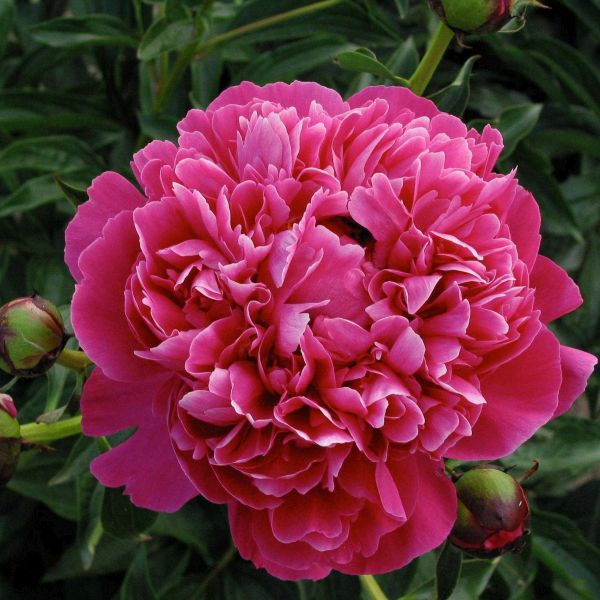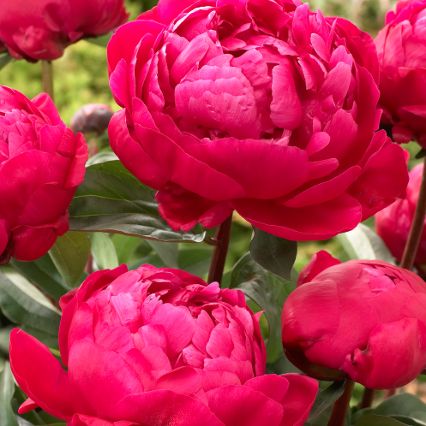

Kansas Peony
Paeonia lactiflora 'Kansas'
96 reviews
Kansas Peony
Paeonia lactiflora 'Kansas'
96 reviews
2.5 Gallon
We are sorry, product is currently out of stock due to seasonal availability. Please check the "Related plants available in your area" section below
Not just beautiful - intentionally selected by ShrubHub's 3D landscape design team to fit real-world spaces and maximize yard potential.
Why Kansas Peony?
The Kansas Peony is a popular variety of peony due to its large, bright pink blooms and its ease of cultivation. It is a long-lived perennial plant that thrives in rich, well-draining soil and full sun to partial shade. The Kansas Peony is a reliable bloomer, producing flowers in late spring or early summer that are prized for their fragrance and beauty. It is a favorite among gardeners and flower enthusiasts alike.
Sunlight
Kansas Peonies require full sun to thrive. They should ideally be planted in a location where they can get at least 6 to 8 hours of direct sunlight daily for optimal growth and blooming.
Watering
Kansas Peonies generally require around 1 inch of water per week during their active growing season. However, it is important to ensure that the soil is well-drained to prevent waterlogging and rot.
Fertilizing
Kansas Peonies require a balanced fertilizer with a 10-10-10 NPK (nitrogen, phosphorus, potassium) ratio for optimal growth and flowering.
Experience Prairie Poetry with Kansas Peony: A Blooming Ballad in Your Garden
Immerse yourself in the lyrical beauty of the Kansas Peony, where petals unfurl like verses of a prairie poem. This blooming ballad promises to serenade your senses and transform your garden into a poetic masterpiece.
The Kansas Peony is nature's stanza, its lush blooms painting a picture of elegance against the backdrop of your landscape. Picture a garden adorned with these floral verses, each petal a delicate brushstroke that weaves a tale of beauty and grace.
As the seasons flow, the Kansas Peony crescendos in a symphony of blooms, evoking the spirit of the prairie's ever-changing landscapes. Witness the petals dance to nature's rhythm, swaying in the breeze and enchanting all who encounter their harmonious embrace.
Whether standing proudly as a solo performer or mingling with other floral notes, the Kansas Peony thrives in diverse settings, adapting seamlessly to your garden's melody. Its versatility ensures your landscape remains a canvas of natural elegance, showcasing the peony's timeless poetry.
A haven for wildlife, the vibrant Kansas Peony invites pollinators to join the chorus as it creates a bustling expression of life within your garden.
Embrace the elegance of blooming petals and let your landscape become a living sonnet. Order now and let the Kansas Peony compose a ballad of charm in your outdoor haven.
Plant Information:
| Botanical Name: | Paeonia lactiflora 'Kansas' |
| USDA Zones: | 3 - 8 |
| Water: | Medium |
| Exposure: | Full Sun |
| Soil Needs: | Well drained |
| Mature Height: | 2 - 3 feet |
| Mature Spread: | 2 - 3 feet |







Pollination Info
Pollination Info for Kansas Peony (Paeonia lactiflora 'Kansas')
Peonies are typically pollinated by insects such as bees, butterflies, and moths. The Kansas Peony (Paeonia lactiflora 'Kansas') is no exception.
The Kansas Peony is a herbaceous perennial plant that produces large, showy flowers that are usually pink, but can also be white or red. These flowers are pollinated by attracting pollinators with their bright colors and sweet fragrance.
It is important to note that the Kansas Peony is a self-fertile plant, meaning that it can produce viable seeds without external pollination. However, cross-pollination by insects can result in genetic variability and potentially more robust offspring.
Peonies are known to produce copious amounts of nectar, which is a key reward for pollinators. The nectar is produced at the base of the flower, within the nectary gland. When a pollinator visits the flower and comes into contact with the anthers and stigma, pollen is transferred from one flower to another, or from one part of the same flower to another.
The Kansas Peony is a beautiful and functional addition to any garden, and its prolific pollination capabilities make it a great choice for gardeners who appreciate the role of pollinators in the ecosystem.
FAQ
Kansas Peony (Paeonia lactiflora 'Kansas') FAQ
What is the Kansas Peony?
The Kansas Peony, also known by its scientific name Paeonia lactiflora 'Kansas', is a popular herbaceous flowering plant known for its large and fragrant blooms. It is native to China and Japan and is commonly found in gardens across North America and Europe.
What does the Kansas Peony look like?
The Kansas Peony typically grows to be 3-4 feet tall and 2-3 feet wide. It produces large, fragrant flowers that can be up to 8 inches in diameter. The flowers are usually deep red or pink in color, with dark green foliage.
When does the Kansas Peony bloom?
The Kansas Peony blooms in late spring or early summer, usually in May or June. The blooming period typically lasts for 7-10 days.
How do I care for my Kansas Peony?
The Kansas Peony requires well-drained soil and plenty of sunlight to thrive. It should be planted in a spot that receives at least 6 hours of sunlight each day. It is also important to water the plant regularly during the growing season and to fertilize it every year in the spring. The Kansas Peony should be pruned back to the ground in the fall to prevent diseases from overwintering in the plant.
What are some common problems with the Kansas Peony?
The Kansas Peony is prone to a number of problems, including powdery mildew, botrytis blight, root rot, and nematode infestations. These issues can be prevented by planting the Kansas Peony in well-drained soil, providing adequate sunlight and water, and practicing good garden sanitation.
Can I grow the Kansas Peony in a container?
While the Kansas Peony can be grown in a container, it is not recommended. The plant requires a large amount of space to grow and can quickly become overcrowded in a container. Additionally, the plant may not be able to tolerate extreme temperatures or changes in soil moisture levels if grown in a container.
Can I cut the flowers of my Kansas Peony for arrangements?
Absolutely! The Kansas Peony is a popular cut flower and makes a great addition to any floral arrangement. However, it is important to wait until the flowers are fully open before cutting them. This will ensure that the flowers last as long as possible in the arrangement.
Planting & Care
Planting & Care for Kansas Peony (Paeonia lactiflora 'Kansas')
Planting Care:
- Choose a location with well-draining soil and full sun to partial shade.
- Plant in the fall or early spring, when the soil is cool and moist.
- Dig a hole that is slightly wider and deeper than the root ball of the plant.
- Place the root ball in the hole and backfill with soil, making sure the plant is level with the ground.
- Water thoroughly after planting.
Care:
- Water regularly, especially during dry spells, to keep the soil moist.
- Mulch around the base of the plant to help retain moisture and suppress weeds.
- Fertilize in the early spring with a balanced fertilizer, following the manufacturer's instructions.
- Remove spent blooms to encourage more flower production.
- Cut back the plant to the ground in the fall after the foliage has died back.
- Divide the plant every 3-5 years in the fall to prevent overcrowding.
- Watch for common pests and diseases such as spider mites, leaf spot, and powdery mildew, and treat as needed.
Check Out These Verified Customer Reviews:
Customer Reviews
4.7 out of 5 based on 96 reviews
Thank you! Your review has been submitted.
Overall great experience with Kansas Peony, will be a returning customer.
Fast shipping, peonies in great shape.
Beautiful peonies, vibrant colors and healthy plants.
Item has been added to your cart.


